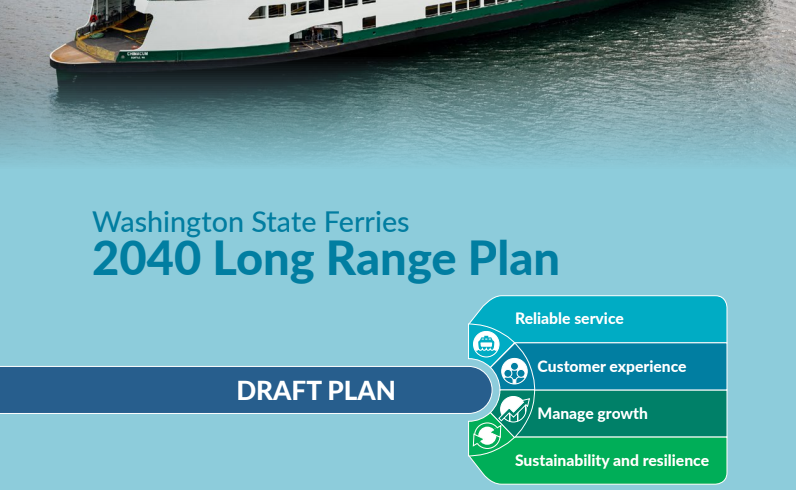Bioacoustic comments on the Washington State Ferries 2040 long-range plan
Today was the deadline for public comments on a 208-page draft “long-range” plan for Washington State Ferries (WSF). For the record, here are my comments (as President of Beam Reach) submitted via their web form. Don’t miss the very end; I really like the idea of hybrid ferries beam-reaching across the Sound under mega-kite power during much of the year!
“Beyond Executive Orders, WSF should acknowledge that underwater noise from ferries has potential environmental impacts on many marine species (not just the Southern Resident Killer Whales), and state a goal of reducing these impacts even if/after orcas are no longer struggling. I’d particularly like to see WSF articulate an understanding that its ferries generate noise at a wide range of frequencies — primarily from 1-1000 Hz where baleen whales emit most signals and have maximum auditory sensitivity, but also from 1,000 to at least 40,000 and possibly >100,000 Hz (at close ranges typical within Puget Sound and the San Juan Islands) where toothed whales emit most signals and have maximum auditory sensitivity. This frequency overlap of ferry noise and marine mammal sensitivity and signals means that WSF should be talking and thinking about minimizing acoustic impacts on SRKWs, Bigg’s killer whales, harbor porpoises, Dall’s porpoises, Pacific White-sided dolphin, minke whales, humpback whales, gray whales, Stellar and California sea lions, harbor seals, elephant seals, northern fur seals, as well as soniferous fish of the Salish Sea. Furthermore, the literature suggests potential impacts on invertebrates and even plankton.
Any design charrette should include consultation with Navy Region Northwest and relevant marine architectural firms with experience in quieting technologies and design/build methods for each ship class (not just ferries). I’m particularly interested in knowing whether there are big reductions in noise from design of unidirectional ferries that use bow thrusters to dock, but have primary propulsion only in one direction (thereby NOT having free-wheeling or reversing propellers at the current bow of the ship — the suspected source of the “clickety-clack” underwater noise signature of WSF ferries). New construction contracts should include noise emission standards that result in lower levels of noise (from 1 Hz -100,000 Hz) from the new vessel relative to noise levels of the vessel being replaced (or in the case of ferries add to the fleet, relative to the median noise spectrum for the fleet). Over time, the WSF fleet noise levels should decrease, ideally to ancient ambient noise levels (e.g. the 5% quantile of 1 minute spectrum levels).
Please ensure hybrid or all-electric ferries will be quieter (at all frequencies) than the vessel they replace? There is a danger that demand for faster ferries will result in increased noise levels; though the new vessel is quieter at the replaced vessel’s normal speed, it may be louder when operated at a new, faster speed (e.g. in order to increase reliability or reduce transit times).
As the old vessels are replaced, their source spectrum levels should be measured (at least opportunistically, e.g. in partnership with the Orcasound hydrophone network, or ideally via an ANSI-compliant methodology similar to the one employed by BC Ferries through a contract with JASCO). Similarly, new vessels should be measured using the same methodology so that the public can be assured that over the long-term, noise spectrum levels received by local marine species from the WSF fleet decrease to near natural ambient noise levels. If a new vessel under normal operating conditions has higher source levels (at any frequency relevant to local species) then it should NOT be accepted as a replacement!
Finally, two high-level thoughts:
1) Don’t forget that in some cases as ridership grows and more trips are made per day, that on some routes it may be a good long-term investment for the State to fund a tunnel or a bridge!
2) In the non-summer months, there are often strong north-south winds blowing across many WSF routes, most of which are oriented east-west. This suggests to me that there may be impressive gains in fuel efficiency and noise reduction by including sails or kites in the design of new, green ferries. There are recent precedents for such renewable propulsion in the commercial shipping sector (e.g. fixed sails and/or automated kites). Remember that a beam reach is the most powerful point of sail, and you’re on one most of the time!”
Read More



 Twitter
Twitter LinkedIn
LinkedIn Facebook
Facebook